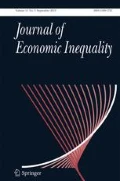Abstract
This paper seeks to compare income distributions from the opportunity advantage viewpoint. That is a measure of how likely it is for a representative individual of one society to receive a higher income than a representative individual of another. Opportunity advantage tries to measure the income opportunities a society offers to an individual, relative to other societies, evaluated from the “veil of ignorance” viewpoint. We show that this notion can be precisely formalised and results in a complete and cardinal income distribution evaluation. We also present an empirical illustration of the gender differences in wage distributions in Spain after the financial crisis. The results show that this criterion offers new insights into the evaluation of differences in opportunity.
Similar content being viewed by others
References
Bentham, J.: A Fragment on Government. Clarendon Press, London (1891). Facsimile of the 1776 edition
Border, K.C.: Fixed point theorems with applications to economics and game theory. Cambridge University Press, Cambridge (1985)
Brin, S., Page, L.: The anatomy of a large-scale hypertextual web search engine. Comput. Netw. ISDN Syst. 30, 107–117 (1998)
Chakravarty, S.R.: Inequality, polarization, and poverty. Advances in distributional analysis. Springer, New York (2009)
Fleurbaey, M.: Fairness, Responsibility, and Welfare. Oxford University Press, Oxford (2008)
Gastwirth, J.L.: Measures of earnings differentials. Am. Stat. 29(1), 32–35 (1975)
Herrero, C., Villar, A.: The balanced worth: A procedure to evaluate performance in terms of ordered attributes. Soc. Indic. Res. 140, 1279–1300 (2018)
INE: Encuesta de Estructura Salarial (EES). Metodología, Instituto Nacional de Estadística, Madrid. Microdata available at: https://www.ine.es/dyngs/INEbase/es/operacion.htm?c=Estadistica_C&cid=1254736177025&menu=resultados&secc=1254736195110&idp=12547359765 (2017)
Le Breton, M., Michelangeli, A., Peluso, E.: A stochastic dominance approach to the measurement of discrimination. J. Econ. Theory 147, 1342–1350 (2012)
Lieberson, S.: Rank-sum comparisons between groups. Sociol. Methodol. 7, 276–291 (1976)
Palacios-Huerta, I., Volij, O.: The measurement of intellectual influence. Econometrica. 72, 963–977 (2004)
Ramos, X., Van de gaer, D.: Empirical approaches to inequality of opportunity: principles, measures and evidence. J Econ. Surv. 30(5), 855–883 (2015)
Ramos, X., Van de gaer, D.: Is inequality of opportunity robust to the measurement approach? Rev. Income Wealth (2020). https://doi.org/10.1111/roiw.12448
Ravallion, M., Chen, S.: Measuring pro-poor growth. Econ. Lett. 78, 93–99 (2003)
Roemer, J.: Theories of distributive justice. Harvard University Press, Cambridge (1996)
Roemer, J.: Equality of Opportunity. Harvard University Press, Cambridge (1998)
Roemer, J.E., Trannoy, A.: Equality of opportunities, Chapter 4. In: Atkinson A.B.,Bourguignon F. (eds) Handbook of Income Distribution, pp. 217–300, North Holland, Amsterdam (2015)
Roemer, J.E., Trannoy, A.: Equality of opportunity: Theory and measurement. J. Econ. Lit. 54(4), 1288–1332 (2016)
Salas, R., Bishop, J., Zeager, L.: Second-order discrimination and generalized Lorenz dominance. Rev. Income Wealth 64(3), 563–575 (2018)
Sanz de Galdeano, A., Terskaya, A.: The labour market in Spain 2002–2018 ̈, IZA World of Labour (2020)
Thomson, W.: Consistency and its converse: an introduction. Rev. Econ. Des. 15, 257–291 (2011)
Villar, A.: Lectures on inequality, poverty, and welfare. Springer-Verlag, Berlin (2017)
West, J.D., Bergstrom, T.C., Bergstrom, C.T.: The EigenfactorTM Metrics: A network approach to assessing scholarly journals. Coll. Res. Lib. 71, 236–244 (2010)
Acknowledgements
We thank two anonymous referees and the Associate Editor K. Decancq for very helpful comments that led to a substantial rewriting and improvement of the original paper. We have also benefited from the discussion with Joan Esteban. The first author acknowledges financial support from the Spanish Ministerio de Economía, Industria y Competitividad under projects ECO2015-65820P and PID2019-107081GB-I00, the Generalitat Valenciana under PROMETEO 2109/037, and IMeRA. The second author acknowledges financial support from the Spanish Ministerio de Economía, Industria y Competitividad under project ECO2015-65408-R (MINECO/FEDER).
Author information
Authors and Affiliations
Corresponding author
Additional information
Publisher’s note
Springer Nature remains neutral with regard to jurisdictional claims in published maps and institutional affiliations.
Supplementary Information
ESM 1
(DOCX 45 kb)
Rights and permissions
About this article
Cite this article
Herrero, C., Villar, A. Opportunity advantage between income distributions. J Econ Inequal 19, 785–799 (2021). https://doi.org/10.1007/s10888-021-09488-5
Received:
Accepted:
Published:
Issue Date:
DOI: https://doi.org/10.1007/s10888-021-09488-5
Keywords
- Domination probabilities
- Income distribution
- Opportunity advantage
- Ranking distributions
- Veil of ignorance



